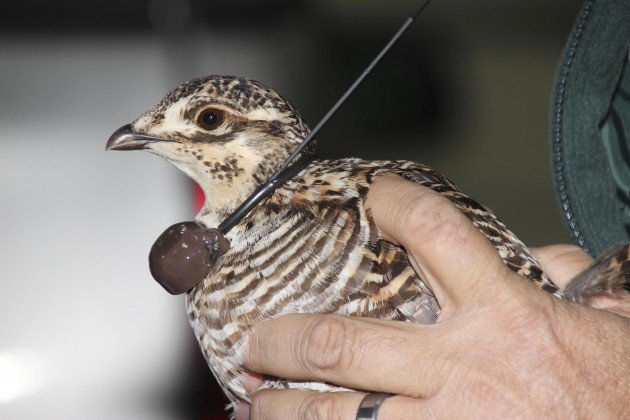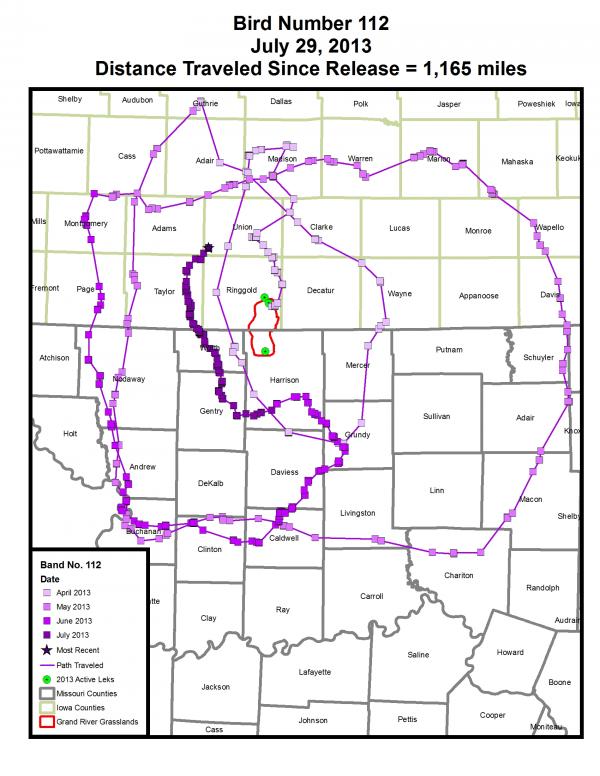
That’s what scientists would like to know. (And actually, this particular Greater Prairie Chicken crossed two states.) After being nabbed in Nebraska and outfitted with a GPS collar in April of this year, Bird No. 112 was released in Iowa and has since traveled a circuitous route of more than 1,100 miles across two states.
Researchers don’t know if this type of journey is the exception or the rule for Greater Prairie Chickens. But they’re hoping that following the birds’ whereabouts will help reveal more about their preferred habitat. That could, in turn bolster efforts to boost population numbers in places like Missouri, where Greater Prairie Chickens barely register in the triple digits.
 This map shows Bird No. 112’s meanderings across Iowa and Missouri. According to the Missouri Department of Conservation, “The upper green dot is a lek at the Kellerton Wildlife Management Area in Iowa where Bird No. 112 was first released. The lowest green dot is Dunn Ranch in Harrison County, Missouri, where prairie chickens were also released and are being tracked. The darker the square, the more recent the bird’s position. The longest single movement was about 24 miles on April 25 from Grundy County to Mercer County, Missouri.” (Image credit goes to Jennifer Vogel from Iowa State University.)
This map shows Bird No. 112’s meanderings across Iowa and Missouri. According to the Missouri Department of Conservation, “The upper green dot is a lek at the Kellerton Wildlife Management Area in Iowa where Bird No. 112 was first released. The lowest green dot is Dunn Ranch in Harrison County, Missouri, where prairie chickens were also released and are being tracked. The darker the square, the more recent the bird’s position. The longest single movement was about 24 miles on April 25 from Grundy County to Mercer County, Missouri.” (Image credit goes to Jennifer Vogel from Iowa State University.)













Great graphic!
Meredith has taken a very brief look at a very complex treatment of a wonderful species in deep trouble. Gr. Prairie Chickens are the subject of our next one hour film, which will be completed within the next few months. Editing will be completed by the end of the year and the film should be broadcast by next spring on many (~80%) of PBS affiliate stations nation wide.
She is slightly incorrect in asserting that this female’s behavior is somehow exceptional. Dr. John Toepfer has tracked hundreds of Gr. Prairie Chickens over 3 decades. Wandering and returning to specific locations is certainly not unheard of. However, in Iowa and Missouri, the meanderings has NOTHING to do with the problems the birds face. Well, perhaps I should restate that- because- In fact, the documented wandering is very likely directly related to the single fact that the postage stamp of habitat in a desert of corn and soybeans is simply insufficient.
Missouri Department of Conservation has steadfastly refused to address the issue -known by all- on how to solve the dramatic decline of prairie chicken populations. They play games with numbers and waste time while land prices climb. Biting the bullet on habitat destruction, climate change, over use of herbicides, pesticides and even fertilizers- (eg – anhydrous ammonia) are difficult to get an allegedly non-political agency to address. God forbid they should make a single human enemy- instead of preforming the function which the state charter specifically assigns them.
Missouri once had over 6.9 MILLION Gr. Prairie Chickens- today less that 200 birds remain.
Missouri Department of Conservation administration continue to ignore Dr. Toepfers recommendations – meanwhile populations continue to decline.